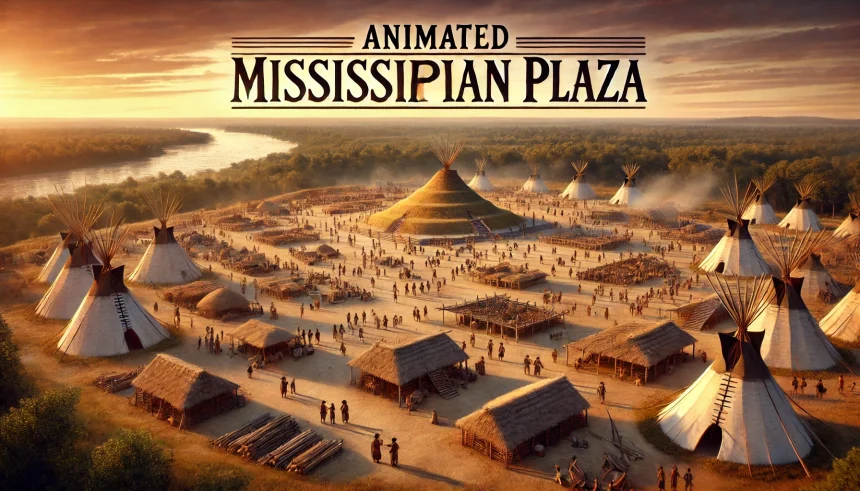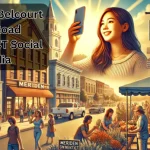Imagine stepping into the bustling animated Mississippian plaza of ancient Native American civilizations, watching people gather for trade, ceremonies, and communal events. This innovative digital reconstruction offers a way to explore what life was like for the Mississippian people who lived in North America from around 800 to 1600 CE.
Through these animated recreations, viewers can interact with virtual spaces, witness daily life, and understand the cultural significance of these remarkable communal centers. This article explores how these digital visualizations help preserve and showcase the rich history of the Mississippian civilization.
Overview of Mississippian Plazas
The Mississippian culture was a widespread and influential Native American civilization that flourished in the southeastern United States. Their communities were known for their massive earthen mounds and well-organized settlements. At the center of these communities were the plazas—large open spaces surrounded by various structures, including monumental mounds, ceremonial buildings, and residential areas. These plazas were the heart of Mississippian life, serving as venues for everything from religious ceremonies to political meetings, communal feasts, and trade.
Key Mississippian Sites with Plazas
- Cahokia: Cahokia, located in present-day Illinois, is the largest and most well-known Mississippian site. It boasts the famous Grand Plaza, a massive open space surrounded by large mounds. It is believed that the plaza hosted important gatherings and ceremonies, making it a central place for both social and religious activities.
- Moundville: Moundville, in Alabama, features a large plaza bordered by mounds, where people came together for religious rituals, games, and meetings. The site also provides evidence of an advanced Mississippian society, with evidence of trade and complex social structures.
- Etowah: Located in Georgia, Etowah features several mounds surrounding a central plaza. Archaeological finds suggest it was used as a political and ceremonial hub, where leaders would address their communities.
These plazas were not just functional; they were designed with purpose, reflecting the cultural and spiritual life of the Mississippian people. The animated recreations of these spaces provide an exciting way to visualize what these ancient communities may have looked like.
Purpose of Animating Mississippian Plazas
The animation of Mississippian plazas serves several vital purposes. First, it allows modern viewers to gain a clearer understanding of how these spaces were used in everyday life. These digital reconstructions make it easier for people to imagine the size, layout, and activities that took place in these plazas.
Educational Value
For students, historians, and archaeologists, these animations are invaluable learning tools. They allow for a deeper understanding of Mississippian culture in a dynamic and engaging way. By interacting with these animated spaces, learners can explore various aspects of the culture, from agricultural practices to religious ceremonies. This makes the past come alive in ways that reading about it in a book never could.
Cultural Preservation
Unfortunately, many Mississippian sites have suffered from erosion, destruction, or natural disasters over the centuries. In some cases, entire cities have disappeared. Animating these plazas helps preserve the cultural memory of the Mississippian people. These digital models allow future generations to appreciate and learn from the intricate architectural and cultural achievements of the Mississippians, even if the physical sites have been lost.
Accessibility
Another important benefit of animated Mississippian plazas is that they make this history accessible to a wide audience. People from all over the world can explore these ancient spaces via digital platforms, allowing them to engage with Native American history in a new, interactive format.
How Animated Mississippian Plazas Are Created
Creating an animated Mississippian plaza is a complex, multi-step process. It combines archaeological research, cutting-edge digital modeling, and artistic creativity to bring the past to life.
Research and Data Collection
The first step in creating an animated plaza is gathering data. Archaeologists and historians study existing physical sites, including mounds, artifacts, and settlement patterns. Detailed surveys are done of the land to map out the layout of the plaza and surrounding structures. This research forms the basis for an accurate reconstruction of the site.
3D Digital Modeling
Once the research is complete, digital artists and archaeologists use 3D modeling software such as Blender or Unity to create virtual representations of the plaza. This software allows them to build a detailed digital version of the site, placing mounds, buildings, and natural features exactly where they would have been in the ancient world.
Animating the Scene
With the plaza constructed, animated figures are added. These digital people help show how the plaza was used in daily life. The animations might depict people engaging in rituals, trading goods, playing games, or even performing agricultural tasks. This adds life and movement to the static landscape.
Environmental Detail
To make the animation even more realistic, digital artists add environmental features such as rivers, trees, wildlife, and changes in the time of day. These details help to recreate the atmosphere of the plaza, allowing viewers to see how it would have appeared at different times of the year or during different weather conditions.
Features of an Animated Mississippian Plaza
An animated Mississippian plaza can include several important features that help bring the space to life. These features are rooted in historical accuracy, providing an authentic portrayal of life in the Mississippian culture.
Architectural Elements
The animated plaza would show central open spaces surrounded by ceremonial mounds. These mounds were often used for religious purposes, as burial sites, or as platforms for important leaders. Around the plaza, there would also be wooden buildings used for public gatherings, communal meetings, and religious ceremonies.
Social Activities
The plaza was a lively space, filled with activity. Animations often depict people engaging in trade, playing chunkey (a game involving rolling stones), or participating in rituals. These activities were central to Mississippian culture and reflect the community-oriented nature of the society.
Natural Environment
The surrounding environment would include rivers, forests, and fields. Wildlife, such as deer and birds, might be visible in the background. Animations can also show seasonal changes, highlighting how the plaza changed throughout the year.
Benefits of Animated Reconstructions
The creation of animated Mississippian plazas has several important benefits, both for educational purposes and for the broader understanding of Mississippian culture.
Enhanced Learning Experience
Animations bring history to life in a way that textbooks or photographs simply cannot. Viewers can virtually walk through the plaza, witnessing firsthand the scale of the structures and the activities taking place.
Support for Archaeology
Digital reconstructions can help archaeologists make sense of physical sites. By visualizing how the plaza might have looked when it was in use, archaeologists can test theories about its function and structure. These animations also help interpret archaeological finds, such as artifacts or burial remains.
Public Engagement
For museums and historical sites, animated Mississippian plazas are a tool to engage visitors. Instead of just looking at a display of artifacts, visitors can immerse themselves in a recreated space. This interactive experience encourages a deeper connection to history.
Future of Animated Mississippian Plazas
As technology continues to improve, the future of animated Mississippian plazas looks even more promising. Advancements in artificial intelligence and virtual reality (VR) are paving the way for even more immersive and accurate reconstructions. In the future, visitors could even experience these plazas in virtual reality, walking through the space as though they were actually there.
Additionally, collaboration with Indigenous communities will play a key role in ensuring that these digital reconstructions reflect the true cultural practices and values of the Mississippian people. By incorporating oral histories and traditional knowledge, these animations can become even more accurate and meaningful.
Conclusion
Animated Mississippian Plaza offers a unique and engaging way to explore the culture and history of the Mississippian people. This digital reconstruction provides a detailed look at the everyday life, social structures, and religious practices that defined this fascinating civilization.
As technology advances, we can expect even more lifelike and interactive recreations that will continue to captivate and educate audiences for years to come. By preserving and sharing the legacy of the Mississippian people in this innovative way, animated Mississippian plaza ensures that their story is never forgotten.













